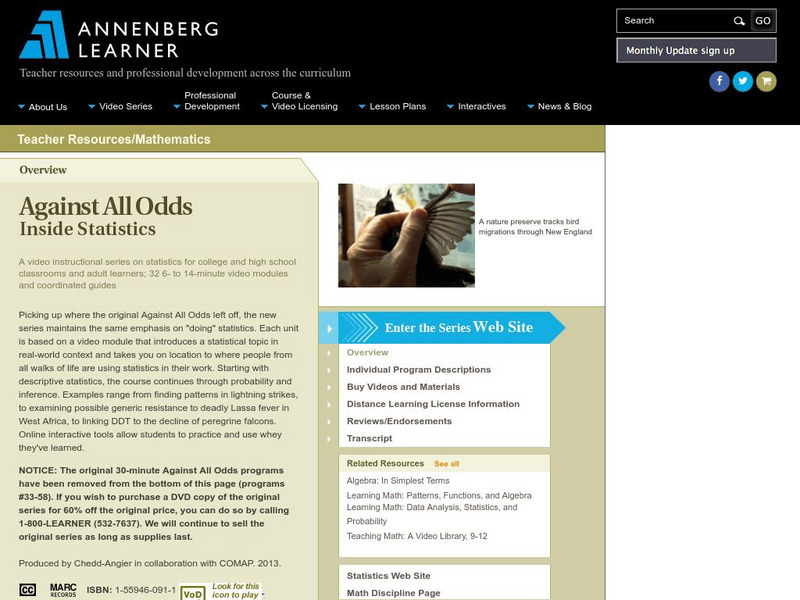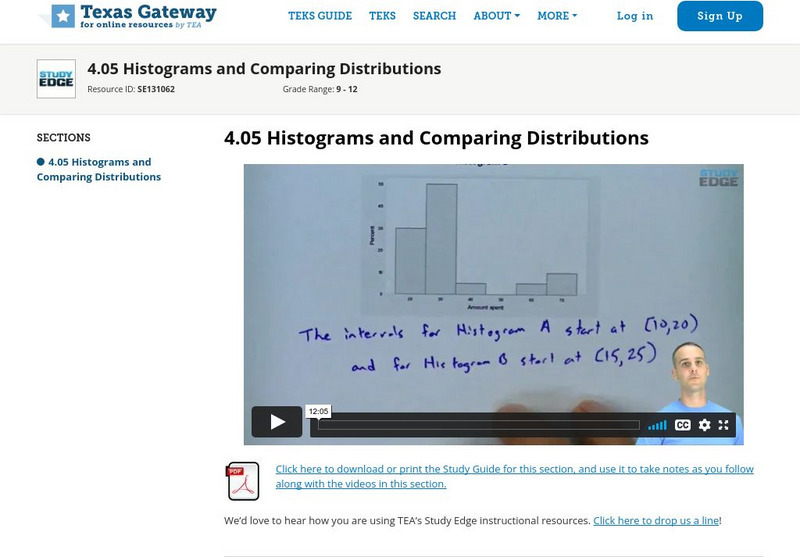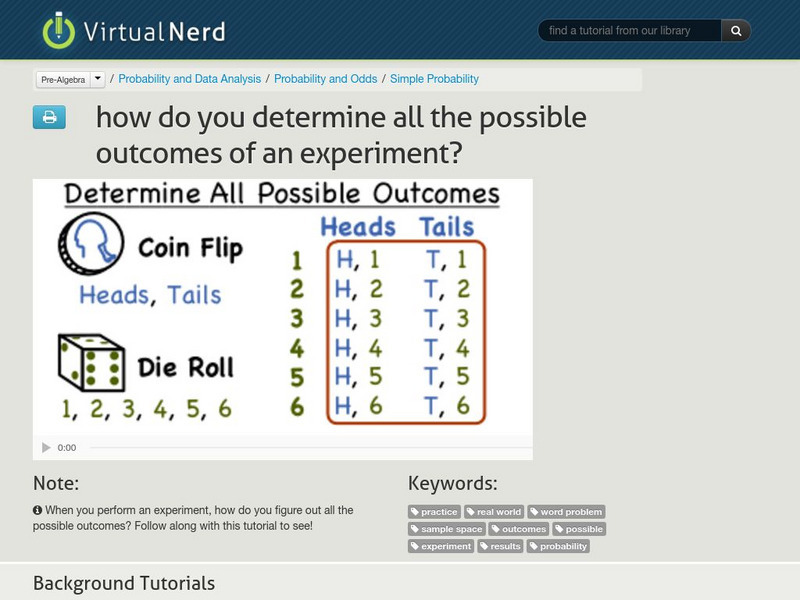Hi, what do you want to do?
Flipped Math
Experimental Design
Experimentally, come up with a study design. Learners hear about different types of study designs, observational studies, and experiments. They identify the subjects, response variable, treatment, and whether there was a cause and...
Crash Course
Chi-Square Tests: Crash Course Statistics #29
Chime in and learn about chi-square tests. An informative video describes when chi-square tests would be appropriate and how to perform chi-square tests. It looks at three different types: the goodness of fit test, the test of...
Crash Course
Degrees of Freedom and Effect Sizes: Crash Course Statistics #28
Give learners the freedom to learn about hypothesis testing. The 28th installment of the Crash Course Statistics series focuses on degrees of freedom and effect size. It looks at how these concepts relate to t-tests and t-distributions.
Crash Course
T-Tests: A Matched Pair Made in Heaven: Crash Course Statistics #27
Pair a video with your lesson on t-tests. Viewers of an informative YouTube video, the 27th part of the Crash Course Statistics series, study two sample t-tests and paired t-tests. They see which test would be appropriate for a situation...
Crash Course
Test Statistics: Crash Course Statistics #26
From t to z, learn about the basics of test statistics. An engaging YouTube video discusses t-tests and z-tests to determine whether observed differences are statistically significant. The video also looks at how p-values play a role in...
Crash Course
P-Value Problems: Crash Course Statistics #22
Ponder the problems of p-values. After reviewing p-values from the last video, the narrator explains some drawbacks of using p-values for hypothesis testing in the 22nd installment of the Crash Course Statistics series. The video...
Crash Course
Playing with Power: P-Values Pt. 3: Crash Course Statistics #23
What went wrong?! The 23rd video in the Crash Course Statistics playlist focuses on errors that occur in hypothesis testing when using p-values. It describes Type I and Type II errors and explains how one type of error might be...
Crash Course
How P-Values Help Us Test Hypotheses: Crash Course Statistics #21
It's my hypothesis that watching the video will have a statistically significant effect on your understanding of p-values. The 21st part of the Crash Course Statistics course focuses on null hypothesis significance testing. It explains...
Annenberg Foundation
Annenberg Learner: Against All Odds: Multidimensional Data Analysis
A look at why multivariate data is collected and how it can be graphed by a computer program for study analysis. The real-life example shown here involves collecting and analyzing data taken from the Chesapeake Bay in order to examine...
Texas Education Agency
Texas Gateway: Study Edge Statistics: Lurking and Confounding Variables
This video discusses lurking and confounding variables which may impact a statistical experiment's results. Includes downloadable study guide with exercises - guide also covers other topics. [5:18]
Texas Education Agency
Texas Gateway: Study Edge Statistics: Histograms and Comparing Distributions
Explains the features of histograms, when they are useful, and the statistical vocabulary that is used when describing them. Also models how to compare and contrast distributions. Includes downloadable study guide with exercises - guide...
Khan Academy
Khan Academy: Statistics: Hypothesis Testing and P Values
Video gives example of hypothesis testing with an example related to medical testing. Includes setting up a null hypothesis and an alternative hypothesis. [11:26]
Khan Academy
Khan Academy: Statistics: Hypothesis Test for Difference of Means
Video demonstration of setting up a hypothesis test and calculating whether the difference of sample means of an experiment falls within a 5% significance level and using that to determine whether to accept or reject the null hypothesis....
Khan Academy
Khan Academy: Statistics and Probability: Study Design: Statistical Questions
Video explaining what the characteristics of a good statistical question are. [9:33]
Khan Academy
Khan Academy: Statistics: Study Design: Types of Statistical Studies
This video explains the different types of study designs used in statistics. [9:51]
Virtual Nerd
Virtual Nerd: What Is an Outcome?
The outcome of an experiment is any possible result of the experiment and is a very important part. Learn about outcomes by watching this tutorial. [2:10]
Virtual Nerd
Virtual Nerd: How Do You Use a Simulation to Solve a Problem?
Simulators are a great way to model an experiment without actually performing the experiment in real life. This tutorial looks at using a simulator to figure out what might happen if you randomly guessed on a true/false quiz. [7:13]
Virtual Nerd
Virtual Nerd: What Is Bivariate Data?
Bivariate data is data that has two variables. Take a look at this tutorial to discover facts about bivariate date. [4:45]
Virtual Nerd
Virtual Nerd: How Do You Use a Scatter Plot to Find No Correlation?
This tutorial takes you through the steps of creating a scatter plot, drawing a line-of-fit, and determining the correlation if any. [1:40]
Crash Course
Crash Course Statistics #9: Controlled Experiments
We may be living IN a simulation (according to Elon Musk and many others), but that doesn't mean we don't need to perform simulations ourselves. Today, we're going to talk about good experimental design and how we can create controlled...
Crash Course
Crash Course Statistics #4: Measures of Spread
This episode looks at measures of spread, or dispersion, which we use to understand how well medians and means represent the data, and how reliable our conclusions are. They can help understand test scores, income inequality, spot stock...
Virtual Nerd
Virtual Nerd: How Do You Compare Two Data Sets Using Box and Whisker Plots?
Learn how to compare two data sets using box-and-whisker plots by watching this video tutorial. [5:28]
Virtual Nerd
Virtual Nerd: How Do You Determine All the Possible Outcomes of an Experiment?
Discover how to figure out all the possible outcomes when performing an experiment by following along with this tutorial. [4:18]




























